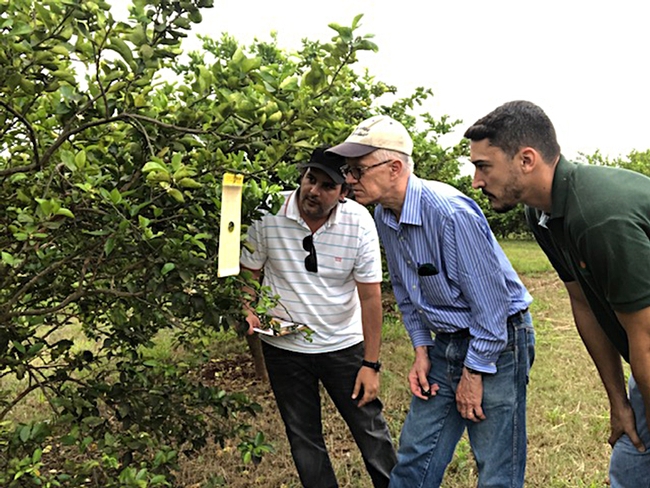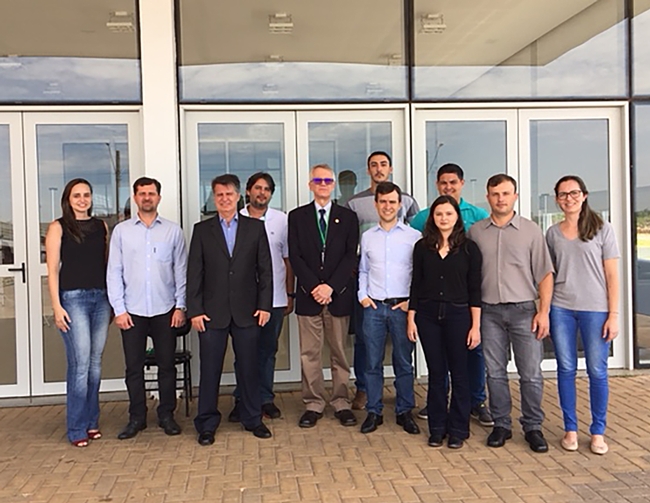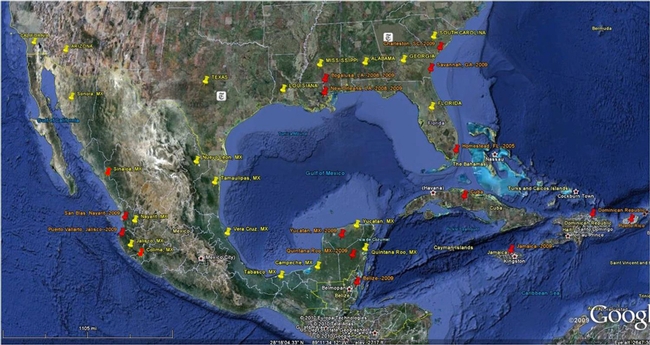Posts Tagged: citrus greening disease
Deadly Citrus Greening Disease: A Better Lure for Asian Citrus Psyllids
If you like or grow citrus, you ought to be worried about the worldwide threat of the deadly citrus greening disease (Huanglongbing or HLB) caused by...

UC Davis chemical ecologist Walter Leal (center) examines a lure in Mogi Mirin, São Paulo on Brazil’s Independence Day (Sept. 7) with Haroldo Volpe (far right) and Renato de Freitas, both of Fundecitrus.
Targeting the Asian Citrus Psyllid
A major citrus pest may experience a “Bah, Humbug!” kind of year. If all goes as planned, UC Davis chemical ecologist Walter Leal's...

The Asian Citrus Psyllid Team: Scientists in the front row (from left) are Tatiana Mulinari, Rodrigo Magnani, Antonio Juliano Ayres, Walter Leal, Marcelo Miranda, Victoria Esperanca, Odimar Zanardi, and Rejane Luvizotto. The three scientists in back are Haroldo X. L. Volpe (white shirt) Renato de Freitas and Rômulo Carvalho.
USDA to provide $11 million for citrus greening research
The USDA will provide $11 million for scientific research to battle citrus greening disease, according to a USDA news release issued this morning. Citrus greening disease is spread by the Asian citrus psyllid, which made its way to California in 2008. When a tree acquires the disease from the pest, nutrient flow is obstructed, the fruit stays green, grows lopsided and tastes bitter.
USDA will invest $2 million this year for research at the U.S. Horticultural Research Laboratory in Ft. Pierce, Fla. The remaining $9 million will be offered in a three-year competitive grants program by the agency's National Institute of Food and Agriculture.
The news release said USDA will also establish a Citrus Disease Research and Development Advisory Committee with representatives from the grower and scientific communities. The advisory committee, which reports to U.S. agriculture secretary Tom Vilsack, will provide leadership to citrus disease scientists.
Citrus greening is one of the most devastating diseases affecting any commercial agricultural crop, according to the National Academy of Sciences. More than 250,000 jobs representing key sectors of the U.S. economy are at risk, including harvesting, packaging, processing, transportation, marketing, retail sales, and nursery production.
Citrus greening threatens to destroy over 1 million commercial citrus acres that have an annual production value of approximately $3 billion across the nation. Yearly losses could reach $10 billion if citrus greening is left unchecked.
Asian citrus psyllid was first detected in California in San Diego and Imperial counties. The pest is believed to have been introduced from northern Mexico. Adult psyllids have also been trapped in Orange, Los Angeles and Ventura counties. The University of California, California Department of Food and Agriculture, USDA and the citrus industry are working closely to quarantine the affected areas and try to eradicate the pest.
The state of Florida first detected the Asian citrus psyllid in 1998 and citrus greening disease seven years later. The pest and disease have been detected in all 30 of Florida's citrus producing counties and in Louisiana, Georgia and South Carolina. The states of Texas, Mississippi and Alabama, like California, have detected the pest but not the disease.

Red pins on the Texas Department of Agriculture map show where citrus greening disease has been found. Yellow pins show where Asian citrus psyllid has been found.

